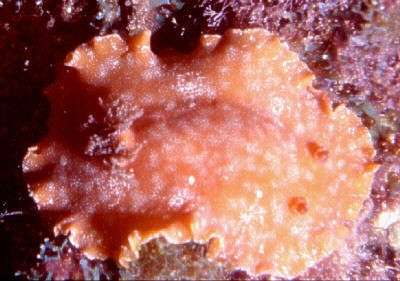
Platydoris argo
(Linnaeus, 1767)
Order: NUDIBRANCHIA
Suborder: DORIDINA
Superfamily: EUDORIDOIDEA
Family: Dorididae
DISTRIBUTION
France to western Mediterranean, and north west Africa.
PHOTO
Gran Canaria Island, Spain,[Canary Ids, off the west coast of Africa]. Approx 8 cm long, depth 2 m, February 1998. Photo: Arthur J. Telle.
Grows to approximately 8cm. Typical platydorid with very flattened body, oval mantle with broad mantle and hard granular texture.
Reference:
• Linnaeus, C. (1767). Systema Naturae, ed. 12, 1(2): 1083, 1089, 1094
Rudman, W.B., 2000 (August 1) Platydoris argo (Linnaeus, 1767). [In] Sea Slug Forum. Australian Museum, Sydney. Available from http://www.seaslugforum.net/find/platargo
Related messages
Re: Alien nudibranchs from Maltese waters?
April 1, 2010
From: Alan Deidun
Concerning message #23398:
Many thks indeed Bill for your prompt and informed feedback on my query - our islands have been experiencing this mass influx of exotics over the past decade, purportedly due to a warming of the basin.
Thanks again,
Alan
alan.deidun@gmail.com
Deidun, A., 2010 (Apr 1) Re: Alien nudibranchs from Maltese waters?. [Message in] Sea Slug Forum. Australian Museum, Sydney. Available from http://www.seaslugforum.net/find/23418Alien nudibranchs from Maltese waters?
March 30, 2010
From: Alan Deidun
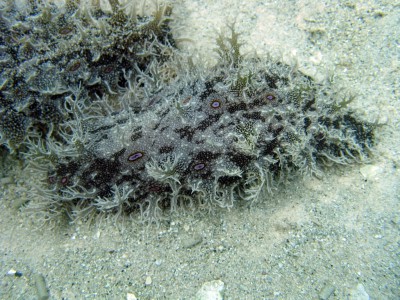
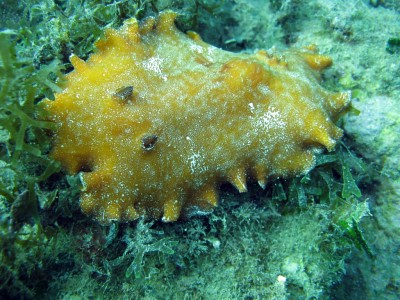
Dear Bill,
This is Alan Deidun from the University of Malta - am attaching 2 photos of nudibranch species recently recorded from Maltese waters - I am pretty sure that the first individual is a Bursatella leachii, but I have no clue as to the identity of the 2nd individual (i.e. shown in lower photo). Can you please help me out? I will obviously acknowledge your assistance.
Locality: coastal area, 20-25m, Malta, Mediterranean Sea. Photographer: Alan Deidun.
Thanks in advance for your generous help,
Alan
alan.deidun@gmail.com
Deidun, A., 2010 (Mar 30) Alien nudibranchs from Maltese waters?. [Message in] Sea Slug Forum. Australian Museum, Sydney. Available from http://www.seaslugforum.net/find/23398Dear Alan,
The upper animal is indeed the late arrival Bursatella leachii but I am pretty sure the second is a yellow form of Platydoris argo, which is a well-known member of the Mediterranean fauna.
Best wishes,
Bill Rudman
Platydoris argo with damaged mantle
September 8, 2008
From: Dominique Horst
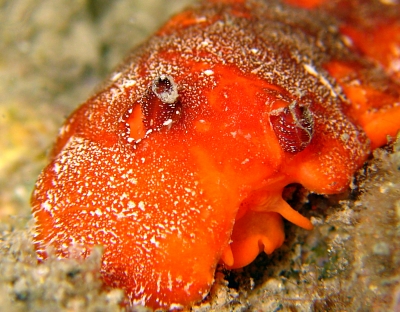
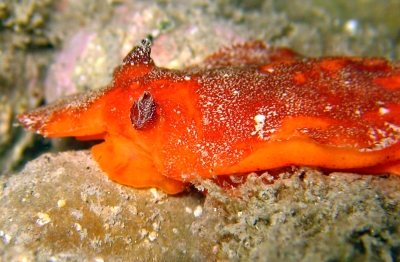
Hi Bill,
This nice Platydoris argo was probably bitten by a predator.
The cut is large, but not I am not sure that any vital organ was damaged?
Locality: Cagnes, 6 m, France, Mediterranean sea, 27 August 2008, muddy. Length: 60 mm. Photographer: Dominique Horst.
Kind regards,
Dom.
dominique.horst@wanadoo.fr
Horst, D., 2008 (Sep 8) Platydoris argo with damaged mantle. [Message in] Sea Slug Forum. Australian Museum, Sydney. Available from http://www.seaslugforum.net/find/21846
Dear Dom,
It doesn't look as though anything vital was damaged - just the mantle 'skirt' which I guess will grow again. It gives us a good view of the head and tentacles which are usually hidden by the mantle skirt.
Best wishes,
Bill Rudman
Re: Unidentified dorid from the Adriatic Sea
August 11, 2008
From: Sven De Vos
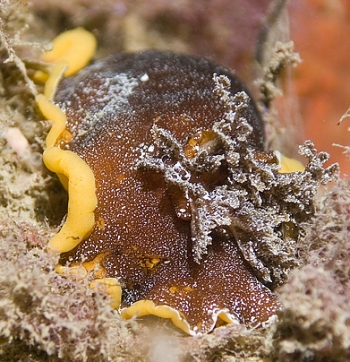
Concerning message #17701:
Hi Marco,
I have a picture of one looking alike, I think it is indeed Platydoris argo.
Sven.
20 m, Algeria, Mediterranean, 1 November 2006. Length: 7 cm. Photographer: Sven De Vos.
Sven
svendv@gmail.com
De Vos, S., 2008 (Aug 11) Re: Unidentified dorid from the Adriatic Sea. [Message in] Sea Slug Forum. Australian Museum, Sydney. Available from http://www.seaslugforum.net/find/21497Thanks Sven,
Bill Rudman
Rudman, W.B., 2008 (Aug 11). Comment on Re: Unidentified dorid from the Adriatic Sea by Sven De Vos. [Message in] Sea Slug Forum. Australian Museum, Sydney. Available from http://www.seaslugforum.net/find/21497Platydoris argo from southern France
July 28, 2008
From: Dominique Horst
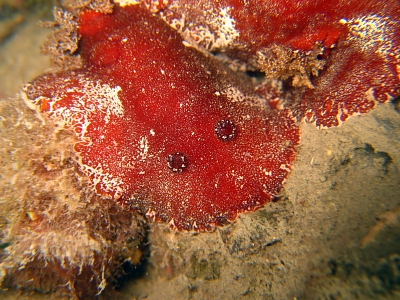
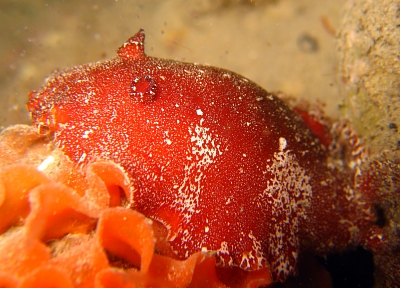
Hello Bill,
I've a couple of Platydoris argo with their eggs ribbon. As you can see their colour is dark red. If the general colour (included eggs) depends on their food, I'm puzzled about what can be this food. I did not see any red orange sponge around, as they are living on mud .... This colour was only on the gorgonian Lophogorgia ceratophyta... Could this be their food?
Locality: Cagnes, 8 m, France, Mediterranean sea, 1 July 2008, muddy. Length: 60 mm. Photographer: Dominique Horst.
Kind regards,
Dom.
dominique.horst@wanadoo.fr
Horst, D., 2008 (Jul 28) Platydoris argo from southern France. [Message in] Sea Slug Forum. Australian Museum, Sydney. Available from http://www.seaslugforum.net/find/21673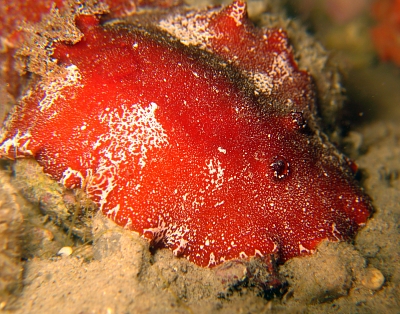
Dear Dom,
Only some sea slugs make use of colour pigments from their food. Some transparent or semi-transparent species with very branching digestive glands take on the colour of their food because we can see it in their digestive system. A few others actually remove colour pigments from their food and incorporate the pigments into their skin. However many of them produce their skin colour genetically. Some have evolved colour patterns to match the colour of their food, but many others have colours which make the animals blatantly obvious. Have a look at the Fact Sheet on colour in sea slugs and the pages on Defence - Colour patterns, and Camouflage.
I am sure P. argo is not eating gorgonians. Concerning the whereabouts of the sponge it is eating. Many sponges are able to survive being covered with a fine layer of silt and debris which can completely hide the presence of the sponge colony. Many can also survive being overgrown by algae. I suspect from your photos that their sponge food is nearby but it is either hidden in a crevice or under a rock, or is covered in a layer of silt or algae. I know the last thing you want to do when diving is to disturb the bottom and make the water murky, but that might be the way to find their food.
Best wishes,
Bill Rudman
Unidentified specimen from Corsica, France
April 24, 2008
From: François Zylberman
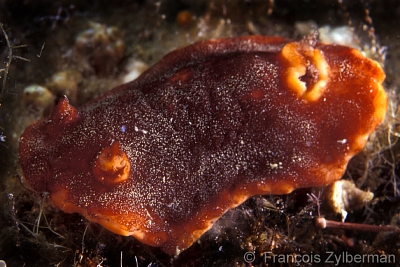
Hi Bill,
I much dived to the Mediterranean Sea and I saw this specimen only once. Do you have an idea of what it is?
Locality: Corsica, 10 m, France, Mediterranean Sea, 15 july 1996. Length: 80 mm. Photographer: François Zylberman.
Thanks
François Zylberman
www.geodia.com
francois@geodia.com
Zylberman, F., 2008 (Apr 24) Unidentified specimen from Corsica, France. [Message in] Sea Slug Forum. Australian Museum, Sydney. Available from http://www.seaslugforum.net/find/20781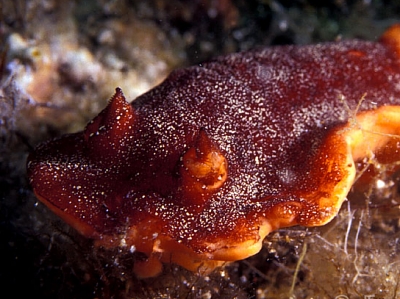
Dear François,
I have been quite puzzled by this photo as well. Its size, colour and very raised gill and rhinophore pockets are just as in Platydoris argo. Unless I am very wrong this animal has had most of the mantle skirt removed. I don't know if this species is known to autotomise its mantle when alarmed, but that could be one means of mantle loss - another could have been the persistent nibbling of a crab or fish. Any other ideas would be welcome
Best wishes,
Bill Rudman
Platydoris argo from Portugal
April 23, 2008
From: Joao Pedro Tojal Loia Soares Silva
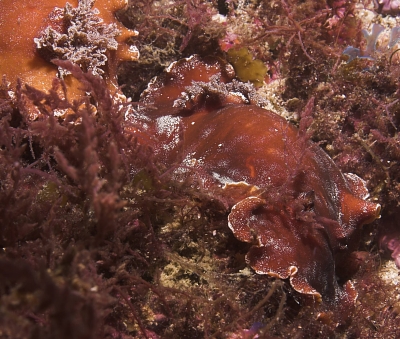
Dear Bill,
While looking for nudibranchs one hardly expects to find individuals over 5 cm long. These two Platydoris argo were well over that mark, measuring aproximately 11cm each, so big I could spot them several meters away.
Locality: Sesimbra, 10m, Portugal, North Atlantic, 20 September 2007, Rocky bottom. Length: 11cm. Photographer: Joao Pedro Silva.
Cheers,
Joao Pedro
jpsilva@uwphotographer.net
Silva, J. P., 2008 (Apr 23) Platydoris argo from Portugal. [Message in] Sea Slug Forum. Australian Museum, Sydney. Available from http://www.seaslugforum.net/find/20798
Thanks Joao Pedro,
Best wishes,
Bill Rudman
Unidentified dorid from the Adriatic Sea
November 7, 2006
From: M. Angelozzi
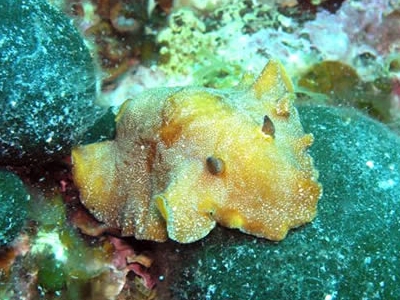
Do you know the name of this sea slug please?
Locality: Tremiti Island, 15-20 m, Italy, Adriatic Sea, May 2006, Rocks. Length: about 10 cm. Photographer: Marco Angelozzi.
Marco Angelozzi
prionace@iol.it
Angelozzi, M., 2006 (Nov 7) Unidentified dorid from the Adriatic Sea. [Message in] Sea Slug Forum. Australian Museum, Sydney. Available from http://www.seaslugforum.net/find/17701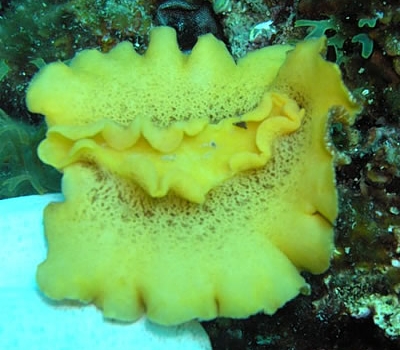
Dear Marco,
My first thoughts were that this may be a colour form of Platydoris argo but I think I should wait until someone with local knowledge can give us advice.
Best wishes,
Bill Rudman
Platydoris argo from the Canary Islands
August 28, 2006
From: Christian Kowalewski
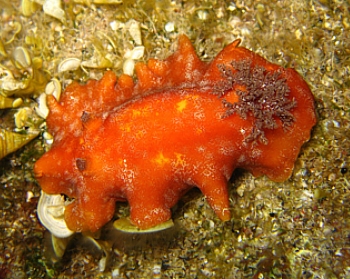
Hallo again,
This time I wasnt diving; I was just making a night tour walking around the rocky areas at low tide; there are lots of more or less deeper pooles (a few cm to a few meters) and I could see lots of individuals of this species (around 20 or 30). From different sizes from really small ones to this one which was around 8 cm long.
Locality: Tenerife Island (Canary Islands), 0 - 2 meters, Spain, Atlantic Ocean, 13 August 2006, interdidal pools. Length: 8 cm. Photographer: Kowalewski Christian.
Thanks
Christian Kowalewski
moratorix@gmx.de
Kowalewski, C.J., 2006 (Aug 28) Platydoris argo from the Canary Islands. [Message in] Sea Slug Forum. Australian Museum, Sydney. Available from http://www.seaslugforum.net/find/17569Thanks Christian,
Bill Rudman
Platydoris argo from Turkey
November 28, 2003
From: Umut Tural
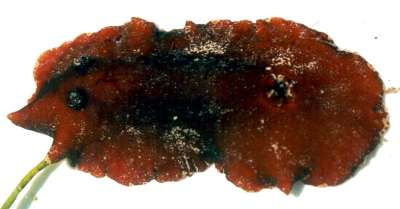

Dear Dr.Bill Rudman ,
I found a nudibranch at 16 meters depth during the research of biological diversity of Datça-Bozburun, on the south coast of Turkey in Mediterranean sea that I couldn't identify. There aren't any lines, points or spots on the specimen, its just simple & orange ... I need your help, I would appreciate, if you could identify this specimen
Best regards
Umut Tural
umuttu@tnn.net
Tural, U., 2003 (Nov 28) Platydoris argo from Turkey. [Message in] Sea Slug Forum. Australian Museum, Sydney. Available from http://www.seaslugforum.net/find/11492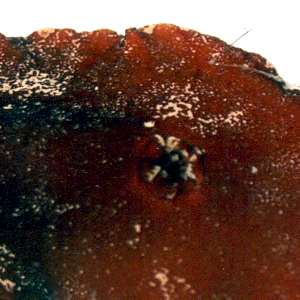
Dear Umut,
I am pretty sure this is Platydoris argo. I have included alongside a closeup showing the gill pocket and the surrounding mantle. You can see that the mantle is covered in low rounded tubercles and with the gills retracted you can see that the gill pocket has a series of triangular folds which close together to protect the gills. These, and the thin but stiff, leathery, mantle skirt are characteristics of the genus Platydoris.
Best wishes
Bill Rudman
Re: Platydoris argo from Turkey
July 31, 2003
From: Ron Velarde
Dear Bill, Haluk and Ferda,
What are the chances? In taking a close look at the photos from the two postings, I think they are the same animal! If you compare the white markings on the right side of the dorsum near the brown patches and near the rhinophores, they are identical. [see message 1, message 2.]
Ron Velarde
rvelarde@sandiego.gov
Dear Ron,
I have just had an email from Ferda saying that he and Hayuk were diving together at Kekova Island and both photographed the animal to make sure they got a good photo of it. Another mystery solved
Cheers,
Bill
Platydoris argo from Turkey
July 24, 2003
From: Ferda Buyukbaykal
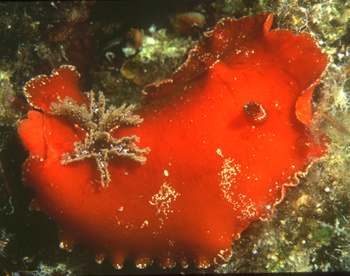

Hello Bill,
I found a new nudibranch in Bes Ada, Turkey this week end [July 2003]. It was 28-30 mt deep , algae and stone bottom and size 8-10 cm.
Do you know this nudibranch's name?
Ferda Buyukbaykal
ferdabbaykal@isnet.net.tr
Buyukbaykal, F., 2003 (Jul 24) Platydoris argo from Turkey. [Message in] Sea Slug Forum. Australian Museum, Sydney. Available from http://www.seaslugforum.net/find/10539Thanks Ferda,
I am pretty sure this is a very bright red version of Platydoris argo. I am just posting a message from Haluk Akbatur, with an animal which looks identical in colour to yours. If it is, does that mean your locality 'Bes Ada' is somewhere on Kekova Island? To make interesting records like yours scientifically valuable, there needs to be enough information in the locality data for someone with little knowledge of the locality - be it Turkey, Australia or the USA - to be able to find it fairly easily. I could find where Kekova Island is, but I can't find Bes Ada.
Best wishes,
Bill Rudman
Platydoris argo from Turkey
July 24, 2003
From: Haluk Akbatur

Dear Bill,
We have found this Platydoris argo at Kekova.
Size: 9 x 4 cm.
Depth: 27 m.
Place: Kekova Is., Antalya, Turkey
Date: 4 July 2003
Haluk
lasergoz@ttnet.net.tr
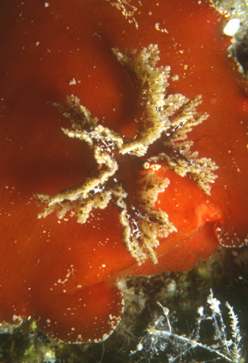

Thanks Haluk,
I have not seen such a bright red specimen before. It must have been a spectacular sight when you found it
Best wishes,
Bill Rudman
Platydoris argo from French Mediterranean
July 22, 2002
From: Marina Poddubetskaia
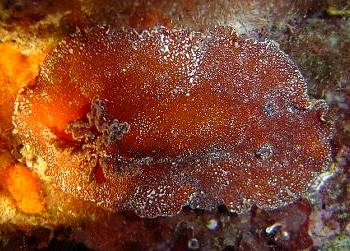
Dear Bill,
There are some photos of Platydoris argo and its well known egg-ribbon from the Mediterraean coast of France.
UPPER: July 06, 2002, Cerbere, France. Site: Canadells interieur, Depth: 10m, Size: 9-10cm
LOWER: July 02, 2002, Cerbere, France. Site: Cap Negre, Depth: 14m, Size: animal = 5-6cm / egg-ribbon = 4-5cm
Photos: Marina Poddubetskaia - Nembro website
Best wishes,
Marina.
nembro@nembro.info
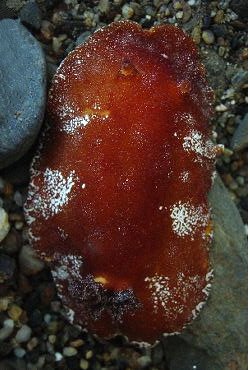

Thanks Marina,
Bill Rudman
Platydoris argo from Spain
August 11, 2000
From: Erwin Koehler


Bill,
Here are some photos of Platydoris argo from my recent trip to Spain, Cala Joncols near Roses (Costa Brava), July 2000. I met within a week 10 individuals, 4 pairs "trailing" like Risbecia. Schmekel and Portmann (Opisthobranchia des Mittelmeeres) write the maximum size is 55mm, Cattaneo-Vietti, Chemello and Giannuzzi-Savelli (Atlas of Mediterranean Nudibranchs) write the max. known length is 70mm. The smallest individual I met (ek112914) had a length of 67mm, the largest 124mm.
Data:
ek112306: July 25, divesite "La Piscina", depth 19m, size 82mm
ek112914: July 28, divesite "La Payita", depth 14m, size 67mm
Erwin
Medslugs.Koehler@t-online.de
Koehler, E., 2000 (Aug 11) Platydoris argo from Spain. [Message in] Sea Slug Forum. Australian Museum, Sydney. Available from http://www.seaslugforum.net/find/2871Dear Erwin,
I use to confuse the names Platydoris argo with Archidoris pseudoargus but with your photos of the former, and the recent discussion about Archidoris pseudoargus, I shouldn't do that again.
I have posted your interesting series of photos showing P. argo 'trailing' like in species of Risbecia, as a separate message.
Best wishes,
Bill Rudman.
'Trailing' in Platydoris argo
August 11, 2000
From: Eriwn Koehler
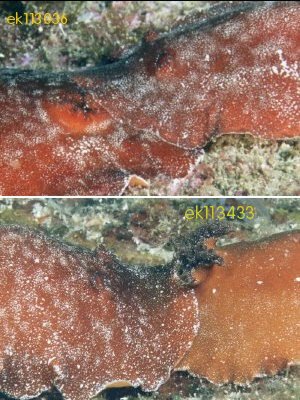
Bill,
Here are some photos of Platydoris argo showing 'trailing' behaviour, like in Risbecia, from my recent trip to Spain, Cala Joncols near Roses (Costa Brava), July 2000. I met within a week 10 individuals, 4 pairs "trailing".
Data:
• ek113036: July 28, divesite "La Caverna", depth 12m, size 97mm (left one) and 85mm
• ek113222: July 29, divesite "Punta de las Figueras", depth 18m, size 104mm and 108mm (upper one)
• ek113431: July 30, divesite "La Piscina", depth 18m, size 124mm (left one) and 89mm
• ek113434: same pair as ek113431
Erwin
Medslugs.Koehler@t-online.de

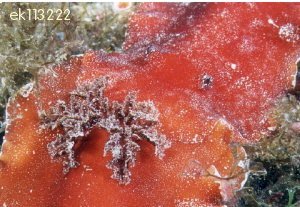
Dear Erwin,
I have put your other photos as a separate message.
I find your observations of Platydoris trailing very interesting. I can't say I have seen any reference to Indo-West Pacific species trailing, so if anyone has observed other species with this behaviour it would be interesting to hear about it.
Best wishes,
Bill Rudman.
Re: Platydoris? from Atlantic
August 2, 2000
From: Angel Valdes
Dear Bill,
The species in Erwin's message is Platydoris argo Linnaeus, 1767.
Platydoris dura Pruvot-Fol, 1951 and probably Platydoris philippi Bergh, 1877 are synonyms of the former.
The two other species mentioned by Erwin, Platydoris maculata Bouchet, 1977 and Platydoris stomascuta Bouchet, 1977 have been described from deep-waters, and probably belong to the genus Baptodoris.
Angel
avaldes@calacademy.org
Valdes, A., 2000 (Aug 2) Re: Platydoris? from Atlantic. [Message in] Sea Slug Forum. Australian Museum, Sydney. Available from http://www.seaslugforum.net/find/2809Thanks Angel,
Bill Rudman.
Re: Platydoris? from Atlantic
August 2, 2000
From: Juan Lucas Cervera
Dear Bill:
Erwin's dorid is Platydoris argo.
Lucas.
lucas.cervera@uca.es
Cervera, J.L., 2000 (Aug 2) Re: Platydoris? from Atlantic. [Message in] Sea Slug Forum. Australian Museum, Sydney. Available from http://www.seaslugforum.net/find/2810Thanks Lucas,
I find these European photos very interesting as they are associated with names that I know from the literature but don't know from personal experience.
Best wishes,
Bill Rudman.
Platydoris? from Atlantic
July 30, 2000
From: Erwin Koehler

Dear Bill,
This photo is from Gran Canaria Island, Spain,[Canary Ids, off the west coast of Africa] taken by Arthur J. Telle,
Email: mercedes@idecnet.com
size about 8 cm, depth 2 m, February 1998, divesite Las Canteras.
I think it is a Platydoris but according to C L E M A M at http://www.mnhn.fr/base/malaco.html
there are reported in Europe:
•Platydoris argo (Linné, 1767)
•Platydoris dura Pruvot-Fol, 1951
•Platydoris maculata Bouchet, 1977
•Platydoris philippi Bergh, 1877
•Platydoris stomascuta Bouchet, 1977
Can you identify it?
Erwin
Medslugs.Koehler@t-online.de
Koehler, E., 2000 (Jul 30) Platydoris? from Atlantic. [Message in] Sea Slug Forum. Australian Museum, Sydney. Available from http://www.seaslugforum.net/find/2247Dear Erwin,
It looks like a Platydoris, and hopefully someone can identify it for us.
Best wishes,
Bill Rudman
